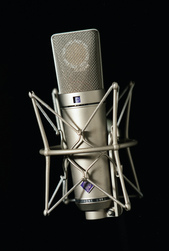 This is a short and very unspecific post from my Voiceover blog about microphone use in the VO world, and how you can use placement and mic choice to affect the sound of the recording, but it also applies to music so I am posting it here too. There is a plethora of information about microphones and their use on the internet, as well as how and when to use different types, and I won't just repeat everything here. However I will give a brief synopsis, and direct you to some good resources. As this is a voiceover blog I will focus this toward that application, but most if not all that I am going to talk about applies to all other microphone use. First things first I am going to commit the ultimate sin of asking you to leave this page and read a very long document. But before you go please pay particular attention to the different types of microphone (dynamic, condenser, tube,ribbon) and the general characteristics and applications of these. Also take the time to really study the polar patterns. Here it is: http://en.wikipedia.org/wiki/Microphone OK so now I expect (if you have come back) you are somewhat sick of microphone talk, so I will stick to the big headlines and how it applies to the world of VO. Often in voiceover you will be using a large diaphragm condenser mic, this has a broad frequency response, by which I mean it hears way down low, and way up high (and everything in-between). You may occasionally come across dynamic mic's such as the SM7b or RE20 (often used in radio), they have a specific frequency range that compliments certain voices, but they are somewhat specific and have their limitations. As you have studied the Wikipedia page you are now aware that different mics have different polar patterns, and depending on what you are recording you will choose one polar pattern over another. Some mic's have one pattern, some give you the option of a few. Rejection A cardioid mic picks up sound in a mushroom shape around the front of the grill, so if you are speaking within this mushroom your voice will be within the mic's ideal range for sound pickup. Undesirable noises such as computer fans can be less intrusive if placed well outside of this region. We call this off axis rejection and it can be used to great effect. Another example is a mic with a Figure 8 pattern which has a very pronounced deaf region between the two pickup regions. Have a look at the polar patterns diagram on the Wikipedia page and you will see the range of options available, and how these can be used to your advantage. Proximity effect Sticking with a cardioid mic we also have to take into consideration the proximity effect. It is very simple, the closer you get to the mic, the more the mic will emphasize the lower frequencies in your voice. Radio DJ's will often get so close to the mic they give themselves lip burn on the grill in an effort to get a bass resonance to their voice. You can use this to your advantage if you don't have much bass in your voice, moving closer will exaggerate what you have. Conversely if your voice is boomy and muddy, moving back a few inches will reduce this bass buildup. However mics set to the omni pickup pattern do not have proximity effect. The benefit to this is that you can get up very close without a change in tone, you do not get any off axis rejection but as you are now right on the grill of the mic, the signal to noise ratio is very high (in favor of the signal!). The mic in omni mode is also much less likely to pop. Your mic may have a high pass filter switch. This simply removes ultra low frequencies (typically 100 cycles and below) from the mic signal before it hits your pre amp. This can help to avoid a muddy sound and possibly remove hum, or accidents like knocking the mic stand, or the rumble of a truck driving by outside. So there it is, a very brief outline of the microphone as used in the world of VO. The microphone is just one part of a chain of equipment and processes that go toward the finished product, but it is the first piece of equipment that your voice encounters and it has a huge impact on your finished product. If you have any questions or comments please feel free to reply here or shoot me a message. Until next time… Jamie
1 Comment
|
Jamie Muffett
I am a British Producer, Mixer & Musician who is privileged to live in New York City. Archives
May 2014
Categories
All
|
 RSS Feed
RSS Feed